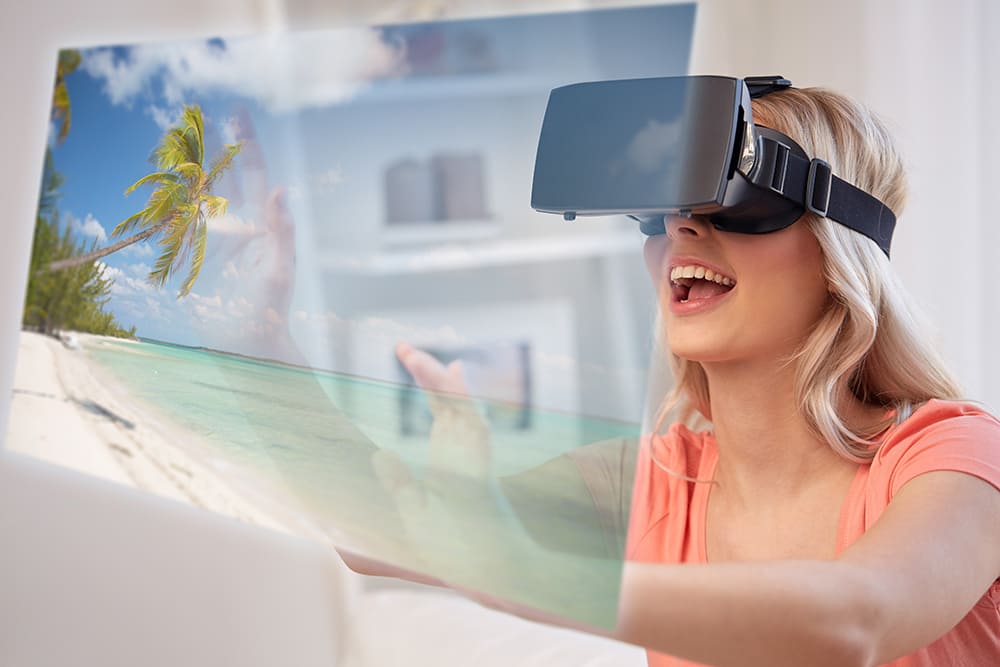Extended Reality In Tourism: 4 Ways VR And AR Can Enhance The Travel Experience
2 July 2021
Travel is a sector that I’m particularly passionate about, and one that’s suffered immensely in the wake of the COVID-19 crisis. As the industry looks to the future, one of its biggest concerns will be how to improve the whole travel experience and reduce some of the “pain points” that come with travel. I believe VR and AR could help with this.
Here are four ways VR and AR can make travel better.

1. Virtual travel
VR allows us to explore new places without physically traveling there, leading some to speculate whether virtual travel could ever replace the real thing. Personally, I don’t think it will. Virtual travel could never compete with the sights, sounds, smells and sensations of being in an exciting new place. But there’s certainly value in being able to explore parts of the world virtually – not least because we can check out destinations before we decide whether to travel there in real life.
Virtual travel can also help visitors experience destinations that are remote, difficult to get to, or need to be preserved without humans trampling around all over the place. The Patagonia VR experience on Oculus Rift is one example of a particularly rich virtual travel experience. Exploring the mountain landmark of Monte Fitzroy, and specifically Laguna Sucia, the remote glacial lake that lies at the foot of the mountain, this VR experience gives users access to a stunning glacial lake that’s hard to reach in real life.
2. Virtual hotel tours
Thanks to virtual tours, holidaymakers can check out hotels in more detail before they book – kind of like a “try before you buy” (or “fly” as the case may be). Several upscale resorts are now embracing virtual tours as a way to show off their stunning locations and world-class amenities, including a number of resorts in The Maldives. Importantly, many of these tours can be experienced using just a smartphone, tablet, or computer, meaning you don’t need a headset to explore your next holiday destination.
In one example, Atlantis, the Palm in Dubai – situated on The Palm Jumeirah, the famous manmade palm-shaped archipelago – has created a stunning 360 panoramic VR video. The video provides a whistle-stop tour of the hotel’s key features, taking in the impressive lobby, the Royal Bridge (the biggest suite in the hotel), one of the underwater suites (yes, underwater), the famous Nobu restaurant, the aquarium, pool, and waterpark, and finishing with a nighttime stroll around the gardens.
3. Test drive excursions and attractions
As well as checking out different hotels, VR can also help travelers test drive different trips and excursions on offer in their chosen destinations. In other words, you can try out various experiences to decide how you really want to spend your time and money when you arrive on vacation. Virtual excursions can therefore help holidaymakers get more out of their precious vacation time.
But VR trips may also help to encourage bookings in the first place – meaning, a customer may be more inclined to book a vacation once they’ve got a better idea of the fantastic excursions on offer in a resort. British travel agent Thomas Cook experimented with immersive VR experiences that allowed customers to try out different excursions, including a helicopter tour of Manhattan. The company reported a 190 percent uplift in bookings for New York vacations after customers tried the five-minute New York VR experience in store. That has to make travel companies, keen to increase bookings after the pandemic, sit up and take notice.
4. Immersive navigation
So, you’ve virtually visited your chosen destination in advance, taken a VR tour of your hotel, and even tried out a few virtual excursions. Now you’ve arrived at your destination and are ready to hit up your first landmark. If only you could find it…
This is where AR can help – specifically, AR-infused navigation. As the go-to navigational app for most of us, it’s no surprise that Google Maps now incorporates an AR feature for those who are navigating on foot. (At the time of writing, it’s not available for users who are driving.) Called Live View and announced in 2019, the AR route-finding feature is available on all ARCore and ARKit-enabled mobile devices, and in any locations where Google already has Street View. The idea is simple: using the Google Maps app and said AR-enabled device, big arrows, and easy-to-follow directions are overlayed onscreen onto the street view, to guide users on which direction to walk and where to turn.
The idea may be simple, but it’s small advances like this that help to make international travel a heck of a lot easier. So, if you ever end up lost in a busy foreign city, or if you simply struggle to make sense of 2D maps, AR-enhanced route-finding is for you.
Where to go from here
If you would like to know more about , check out my articles on:
- Are Alexa And Siri Considered AI?
- How To Put AI Into A Business To Accelerate Performance?
- What Is The Impact Of Artificial Intelligence (AI) On Society?
Or browse the Artificial Intelligence & Machine Learning library to find the metrics that matter most to you.
Related Articles
The Simple ChatGPT Trick That Will Transform Your Business AI Interactions
I believe ChatGPT and other generative AI tools can help pretty much any business.[...]
The Third Wave Of AI Is Here: Why Agentic AI Will Transform The Way We Work
The chess pieces of artificial intelligence are being dramatically rearranged. While previous iterations of AI focused on making predictions or generating content, we're now witnessing the emergence of something far more sophisticated: AI agents that can independently perform complex tasks and make decisions.[...]
How Generative AI Will Change Jobs In Cybersecurity
Ensuring robust cybersecurity measures are in place is more important than ever when it comes to protecting organizations and even governments and nations from digital threats.[...]
The 10 Most Important Banking And Financial Technology Trends That Will Shape 2025
As technological disruption and economic uncertainty continue to reshape the financial landscape, alongside dramatic shifts in consumer behavior and regulatory requirements, 2025 promises to be both challenging and opportunistic for banking and financial services.[...]
The 6 Most Powerful AI Marketing Trends That Will Transform Your Business In 2025
The quiet hum of AI servers is rapidly drowning out the traditional drumbeat of marketing departments worldwide.[...]
AI Everywhere – Scaling AI In The Cloud With Intel® Xeon®6
Today, the omnipresent AI that we’re starting to take for granted has become a critical tool for business.[...]
Sign up to Stay in Touch!
Bernard Marr is a world-renowned futurist, influencer and thought leader in the fields of business and technology, with a passion for using technology for the good of humanity.
He is a best-selling author of over 20 books, writes a regular column for Forbes and advises and coaches many of the world’s best-known organisations.
He has a combined following of 4 million people across his social media channels and newsletters and was ranked by LinkedIn as one of the top 5 business influencers in the world.
Bernard’s latest book is ‘Generative AI in Practice’.










Social Media